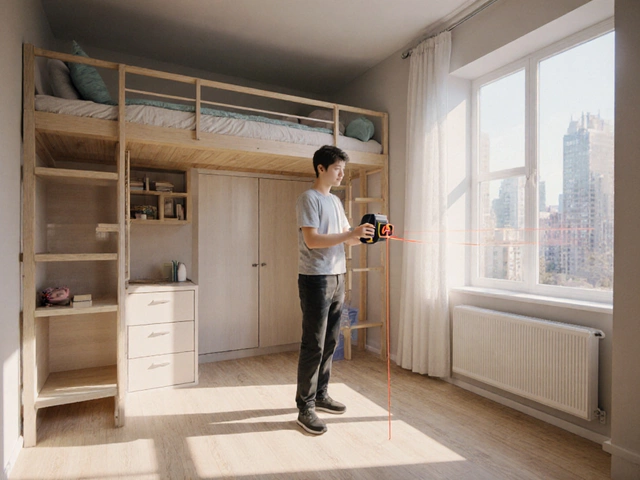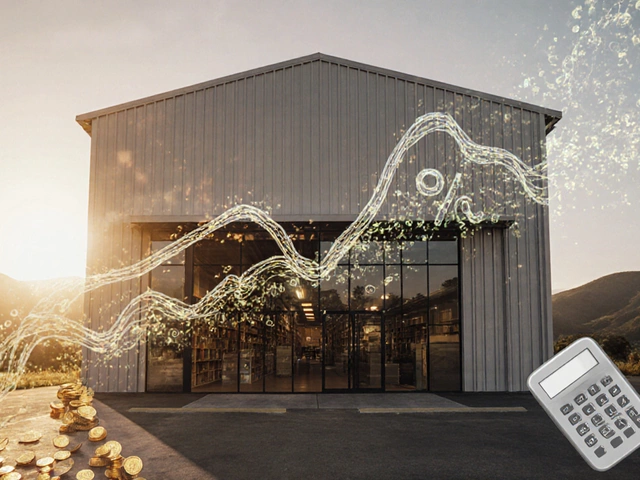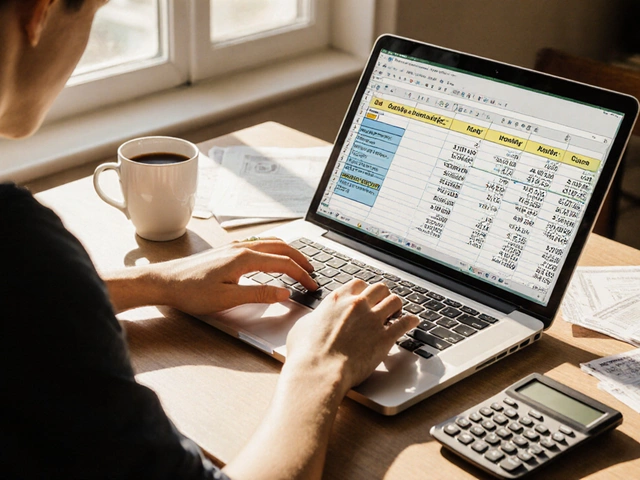How to Calculate Return on Commercial Property: Step-by-Step Guide for Investors

Crunching the numbers on a property is nothing like flipping through real estate listings after dinner. You’ve probably heard about people doubling their money or bragging about rock-solid rental income from that perfectly located office or retail space. But here’s the kicker—what actually is “return” on commercial property? It’s not just the rent you pocket or the value going up over time, it’s a bunch of moving parts. And sometimes, folks who seem confident at the barbecue haven’t done the full math. Thinking about investing, or maybe you already signed a deal? Either way, knowing exactly how to measure your returns can put you miles ahead.
Understanding Commercial Property Return: What You’re Really Measuring
Commercial property isn’t your average home investment. Here, the numbers have teeth. Investors usually want to know two core things: the income generated versus what they paid, and how the building’s value changes. The most common metrics are Net Operating Income (NOI), capitalization rate (cap rate), cash-on-cash return, and internal rate of return (IRR). Each tells a different part of the story. Missing out on any piece is like looking at just the cover of a financial report.
Let’s start with NOI. It’s the money left after you pay operating expenses, like property management, insurance, taxes, repairs, but BEFORE you pay the mortgage. Say your tenants bring in $150,000 in rent each year, and you spend $40,000 to keep the lights on and taxes paid—your NOI is $110,000. Remember, this does not include your mortgage payments. Ever wonder why? It keeps properties on a level playing field, so you can compare even if one investor finances differently.
The cap rate grabs a lot of attention at networking events. It’s just NOI divided by the property’s market value. It shows what kind of annual return you’d get if you paid all cash, no loan at all. Let’s say your $1.5 million property has an NOI of $110,000. Your cap rate is $110,000 divided by $1,500,000, which is about 7.3%. In 2024, the U.S. average for office and retail space hung around 5-7% depending on the city, hovering higher for riskier locations.
Another key figure is cash-on-cash return. This measure is a direct look at what you actually earn compared to what you shelled out from your own pocket. Banks are helping cover most of the purchase price, and you only put in, say, $300,000 down. If after loan payments and everything else, you clear $20,000 a year, your cash-on-cash return is about 6.7%. This matters for folks wanting to see tangible returns on their invested dollars, not just theoretical numbers.
Then there’s IRR. It’s the heavy hitter but also the trickiest. IRR looks at your cash flows over time, including any final sale, and tells you your annualized projected return, essentially showing you the true growth rate of your investment. You’ll want a spreadsheet or an app for this calculation because it takes all the ugly, real-world stuff into account, like selling costs and changes in rent.
Not all returns are created equal. A property with a high cap rate might have more risk, unstable tenants, or be in a less desirable area. A lower cap rate could still be a huge win if the location is red-hot and values are climbing fast. When scoping out deals, get beyond the brochure headline—dig into the details.
The Building Blocks: Income, Expenses, and Beyond
Now for the stuff you can’t ignore: income and expenses. Rents provide the backbone, but don’t forget about things like storage or parking fees. A well-operated building can pull in hidden dollars through services like vending, advertising signs, or premium tenant add-ons. But, of course, money goes out just as fast as it comes in if you don’t watch it.
Here’s a story. Friend of mine bought a small suburban office building in 2022. On paper, the rent per square foot looked juicy. But they missed that the HVAC system was on its last legs, and the property tax got reappraised after sale—expenses jumped by 17% that first year. Their projected return, which was supposed to be 8% cap rate, fell to 5.6%. Ouch. The lesson? Deep dive into every coffee-stained receipt and dull contract.
Here’s a quick breakdown of the major expense buckets:
- Property taxes (biggest shocker for many new investors)
- Insurance (can swing wildly based on location and building type)
- Maintenance and repairs (budget for both routine and those nasty “surprises”)
- Utilities (may be paid by tenants or owner – check the leases!)
- Property Management (worth it for your sanity, but it costs money)
- Legal and accounting (especially as you scale or encounter tenant turnover)
There’s also vacancies to plan for. Almost nobody gets 100% occupancy year in, year out. Most pros budget a 5-10% vacancy rate. For example, if the neighborhood average is a month of vacancy per year, that’s an 8% vacancy loss factored into your return. Real income is the rent collected after tenants move out and incentives are paid.
It pays to spot hidden expenses, too. Renovations might mean keeping the building empty for several months, eating into profits. Or maybe you need extra security, like cameras or guards, if location demands it. Always be a pessimist with expenses; any pleasant surprises make you look like a genius.
Step-by-Step: Calculating Return on Commercial Property
Getting down to brass tacks, here’s how most investors run the numbers. I’m giving you the full steps so you can do this yourself on a napkin or in Excel:
- Estimate total potential income: Add up all rents plus any extras like gumball machines, antenna rentals, etc.
- Subtract vacancies and collection losses: Assume a conservative vacancy rate; most folks use between 5% and 10% depending on the market.
- Calculate effective gross income (EGI): This is your real projected income, not pie in the sky.
- Deduct operating expenses: Go line by line—taxes, repairs, not mortgage.
- Arrive at Net Operating Income (NOI): EGI minus operating expenses. This number is what most comparisons use for value.
- Cap Rate Calculation: Divide your NOI by the purchase price or market value of the property, then multiply by 100 to convert to a percentage.
- Cash-on-Cash Return: After subtracting your mortgage and loan payments, divide your pre-tax cash flow by your actual cash invested (down payment plus closing costs and renovations).
- IRR (Internal Rate of Return): Plug your year-by-year cash flows and eventual sale price into Excel’s IRR formula. This gives you the true long-term performance picture.
Here’s a real-world example in a simple table you can relate to:
| Year | Income | Expenses | NOI | Debt Service | Cash Flow |
|---|---|---|---|---|---|
| 2024 | $150,000 | $40,000 | $110,000 | $75,000 | $35,000 |
| 2025 | $153,000 | $41,000 | $112,000 | $75,000 | $37,000 |
| 2026 (Sell) | $155,000 | $42,000 | $113,000 | $75,000 | $38,000 + Sale Gain |
This is a stripped-down summary, but with these numbers, you could easily calculate cap rate and cash-on-cash return—helping you see if this deal matches your goals.

Tips for Better Returns (and Fewer Headaches)
Getting more rent with fewer problems is every investor’s dream. Sometimes, boosting the bottom line comes from little tweaks, not huge overhauls. Here are some street-smart ways to lift your numbers or defend profits from leaks:
- Consider triple net leases (NNN), where tenants handle the taxes, insurance, and maintenance. This can turn expenses from your headache into theirs.
- Look at cost segregation for your taxes—dividing the building’s components for accelerated depreciation. Your CPA will thank you, and so will your wallet.
- Don’t skimp on tenant screening. Take your time choosing businesses with strong credit and long-term prospects. A few weeks without rent beats years of late payments and headaches.
- Optimize under-used spaces. Can that musty basement become rentable storage? Is the rooftop suitable for billboards or cell towers? Get creative.
- Stay ahead on maintenance. Deferred repairs become expensive nightmares that tank your NOI when you least expect it.
- Negotiate vendor contracts annually. Even long-term property managers, landscapers or cleaners will sometimes drop rates if you ask or offer a longer deal.
Listen, the biggest trap is chasing headline numbers while ignoring hidden risk. I’ve met folks stoked to buy retail buildings in “emerging” areas only to watch crime or new construction flatten their rents. Always learn more about the neighborhood than the brokers want to share.
And yes, pay attention to interest rates. In mid-2024, commercial lending rates rose to around 6-8% for average deals. If you boxed yourself into a low cash flow property, that extra couple percent on your loan can wipe out profits fast. Stress test the property: What if your biggest tenant leaves? What if expenses suddenly rise? Be brutally honest in your scenarios.
Common Pitfalls (And How to Dodge Them)
Even seasoned investors mess up sometimes, usually from going too fast or trusting the wrong numbers. Here are spots where newbies—and sometimes even pros—fall hard:
- Taking pro forma income as gospel. Brokers love to show “potential” rent—make sure it matches actual leases signed, not just hopes and dreams.
- Forgetting about capital expenditures. HVAC, roofs, elevators—big, expensive stuff needs attention every so often. Budget for it from day one.
- Ignoring economic vacancy. If the business across the street is struggling, nearby tenants could leave next. Double check local trends and talk to business owners nearby, not just the seller.
- Underestimating turnover and leasing costs. Getting a new tenant often means broker fees, free rent, and sprucing up the space—all of which chip away at that so-called juicy cap rate.
- Letting emotion take over. Maybe your heart is set on a coffee shop because it looks great, but the numbers stink. Trust your spreadsheets, not your imagination.
- Missing the fine print in loans. Balloon payments, prepayment penalties, or adjustable rates can blow up the best-laid plans.
If you want to spot a solid deal, try this: ask for the actual 12-month trailing income and expenses (called a T-12) as well as any repair invoices. Cross-verify rent rolls with bank deposits, not just paper ledgers. Told you, details matter.
It also pays off to build a team—even if you’re just starting out—of a sharp CPA, a lawyer who reads the details, and even a property manager who knows the quirks in your area. You’ll save your own time and also spot mistakes before you lose money.
Why Understanding Return on Commercial Property Pays Off
Real estate is where fortunes (and fiascos) are made. While everyone talks about hot deals, those who endure are usually the ones who’ve put in the work before writing a check. Calculating return on commercial property isn’t just busywork, it’s your financial reality check before, during, and after every investment.
You don’t need a PhD. You need curiosity and a willingness to double-check everything. When you understand how NOI, cap rate, cash-on-cash, and IRR fit together, you can see past the hype and zero in on deals that actually fit your goals, your risk tolerance, and your life plans.
Real estate can deliver steady wealth. It can also turn into an expensive hobby if you miss the details. So, grab the right numbers, ask the tough questions, and demand proof before you dive in. With this kind of diligence, you’re way ahead of the crowd whispering about secret shortcuts. Honest math doesn’t lie—and in commercial property, it’s your best friend.







Write a comment